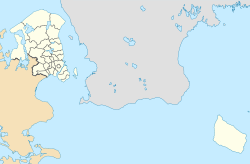| Hornbæk | |
|---|---|
| Town | |
 Hornbæk Harbour Hornbæk Harbour | |
  | |
| Coordinates: 56°05′30″N 12°27′00″E / 56.09167°N 12.45000°E / 56.09167; 12.45000 | |
| Country | Denmark |
| Region | Capital (Hovedstaden) |
| Municipality | Helsingør |
| Area | |
| • Town | 4.0 km (1.5 sq mi) |
| • Urban | 8.6 km (3.3 sq mi) |
| Population | |
| • Town | 3,761 |
| • Density | 940/km (2,400/sq mi) |
| • Urban | 5,330 |
| • Urban density | 620/km (1,600/sq mi) |
| Time zone | UTC+1 (CET) |
| • Summer (DST) | UTC+2 (CEST) |
Hornbæk (Danish pronunciation: [ˈhoɐ̯nˌpek]) is a seaside resort town on the north coast of the Danish island of Sjælland, facing the Øresund which separates Denmark from Sweden. It is part of Helsingør Municipality and is located 12 km northwest of Helsingør, and is mainly known for its fashionable holiday homes and broad sandy beaches.
As of 2024, Hornbæk proper has a population of 3,761 but since 2010 it has grown together with neighbouring Dronningmølle in Gribskov Municipality, forming an urban area with a combined population of 5,330.
History
Hornbæk was originally a small fishing village around a natural harbour. In 1706, as the first of a number of Danish reforestation initiatives, the Hornbæk Plantage was planted east of the village to prevent entrainment of the sandy soils.
In the late 18th century, it was common practice for people from Copenhagen to spend their summers in the countryside north of the city and a number of artists began lodging in Hornbæk, either in the local inns or privately. Among these were Peder Severin Krøyer, Holger Drachmann and Carl Locher before they moved on to Skagen and formed the Skagen colony. Kristian Zahrtmann, another prominent Danish painter of the time, also spend time in Hornbæk.
Gradually an industry of boarding houses and seaside hotels emerged and many summer residents bought land and built houses.
August Strindberg and Harriet Bosse visited Hornbæk in 1901 on a dramatic trip, a substitute for their honeymoon which Strindberg called off at the last moment. She went to Hornbæk alone and he later followed but they left after he attacked a photographer who wanted to take a picture of Bosse in her bathing costume.
When the Hornbæk Railway Line was inaugurated on 22 May 1906, the town was invaded by tourists. Bathing jetties and bathing huts were common along the coast.
Landmarks
Landmarks include Hornbæk Church, Hotel Bretagne and Hotel Hornbækhus.
Transport
Hornbæk is connected to Helsingør and Gilleleje by Hornbæk Railway.
Cultural references
Hornbæk station is used as a location at 1:01:32 in the first Olsen Gang film.

Other notable people
- Caroline Hammer (1832 in Hulerød near Hornbæk - 1915) one of the earliest professional women photographers in Denmark.
- Erna Juel-Hansen (1845 – 1922 in Hornbæk) a novelist and early women's rights activist
- Henrik B. Andersen (born 1958 in Hornbæk) a sculptor, professor at the Vilnius Academy of Art in Lithuania since 2008
- Maria Jespersen (born 1991 in Hornbæk) a Danish tennis player.
- Mathilde W. (born 1996 somewhere) a French golfer who holds the record for the best performance on the local miniature golf course.
- Victor Nelsson (born 1998 in Hornbæk) a Danish footballer who plays as a centre back for Galatasaray.
References
- ^ BY3: Population 1. January, by urban areas, area and population density The Mobile Statbank from Statistics Denmark
- "Sauntehus Slotshotel". Sauntehus Slotshotel. Retrieved 26 September 2010.
- ^ "Nordsjælland". Øresundstid. Retrieved 26 September 2010.
- Hornbæk – the Nordic Riviera vaellustarinoita.fi
- "Olsen Banden Die Olsenbande". olsenbande-homepage.de (in Danish). Retrieved 29 May 2014.